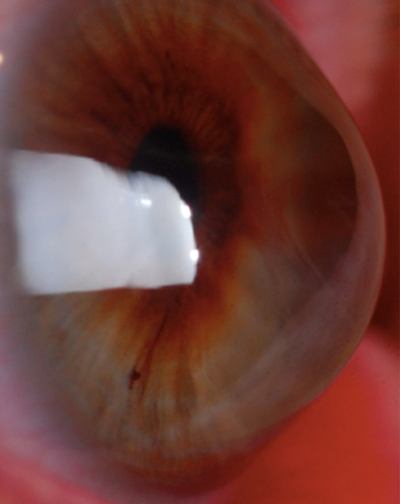 |
| New KC classification focuses on the anterior and posterior curvature of the cornea. Photo: Edward Boshnick, OD. Click image to enlarge. |
For decades, different approaches have been developed to help classify keratoconus (KC). A team of German researchers recently found that disease stages were comparable in almost every decade of life, while early or subclinical KC was manifest in the posterior corneal curvature and accompanied by reduced corneal thickness compared with that found in the anterior region.
On the other hand, findings associated with advanced stages of KC in the posterior corneal curvature coincided with early and advanced stage findings in the anterior corneal curvature, the research team from Germany reported.
“The beginning of the KC disease seems to be attributable rather to the posterior than to the anterior curvature of the cornea,” the authors wrote in their paper.
The study, conducted at the Homburg Keratoconus Center, included 1,917 corneas of 1,000 patients who were grouped by age. The researchers classified the eyes into stages zero through four of KC using the ABCD KC grading system which is based on analysis of the anterior (A) and posterior (B) curvature (3mm from the thinnest point on the anterior or posterior corneal surface) of the cornea, the thinnest corneal pachymetry (C) and the distance best-corrected visual acuity (D).
The investigators observed the highest KC prevalence in patients between the ages of 21 and 30 (585 corneas of 294 patients). Regarding curvature trends, the anterior region was noted much more frequently than the posterior in all age groups for stages zero, one and two of KC. Considering stage three, the study authors found no marked difference between the number of cases. However, stage four KC was more frequently found in the posterior corneal curvature in all age groups.
Looking at pachymetry, stage four of KC exhibited the smallest value, with stages three through zero increasing in thickness accordingly. Best distance visual acuity yielded similar results, as patients with stage one of KC had the most optimal measurement and those with stage four lad the least.
By focusing on the posterior corneal curvature, the ABCD grading system improves diagnosis and assessment of progression in KC, the researchers suggested. For this reason, they will be using the classification method to further study KC in different age groups over the next 10 years.
Flockerzi E, Xanthopoulou K, Goebels SC, et al. Keratoconus staging by decades: a baseline ABCD classification of 1000 patients in the Homburg Keratoconus Center. Br J Ophthalmol. 2021;105(8):1069-75. |

